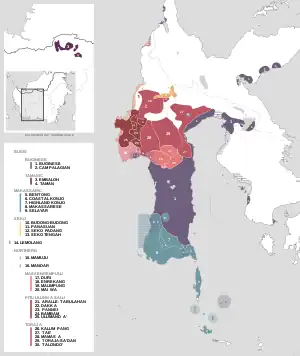South Sulawesi languages
The South Sulawesi languages are a subgroup of the Austronesian language family. They are primarily spoken in the Indonesian provinces of South Sulawesi and West Sulawesi, with a small outlying pocket in West Kalimantan.
| South Sulawesi | |
|---|---|
| Geographic distribution | Indonesia (Sulawesi, West Kalimantan) |
| Linguistic classification | Austronesian
|
| Proto-language | Proto-South Sulawesi |
| Subdivisions |
|
| Glottolog | sout2923 |
 Map showing the distribution of the South Sulawesi languages in Sulawesi and Kalimantan | |
Subgrouping
Internal classification
This classification follows Grimes & Grimes (1987) and the Ethnologue.[1][2]
- Bugis
- Buginese: Buginese, Campalagian
- Tamanic: Embaloh, Taman
- Makassaric: Bentong, Coastal Konjo, Highland Konjo, Makassarese, Selayar
- Seko: Budong-Budong, Panasuan, Seko Padang, Seko Tengah
- Lemolang
- Northern
- Mamuju
- Mandar
- Massenrempulu: Duri, Enrekang, Malimpung, Maiwa
- Pitu Ulunna Salu: Aralle-Tabulahan, Dakka, Pannei, Bambam, Ulumanda’
- Toraja: Kalumpang, Tae’, Mamasa (including Pattae', Central Mamasa, and Northern Mamasa), Toraja-Sa’dan, Talondo’
The position of the Tamanic languages, spoken in West Borneo, was unclear until the end of the last century. The Dutch linguist K.A. Adelaar showed that they are especially close to Buginese and thus can be included in the South Sulawesi subgroup.[3]
Zobel (2020) also classifies the Badaic languages with Seko as part of a Seko–Badaic group within the South Sulawesi branch.[4]
Notes: Italic writing indicates it is considered a dialect and not a separate language.
Position within Austronesian
At the current state of research, the South Sulawesi languages are considered to make up a primary branch of the Malayo-Polynesian subgroup within the Austronesian language family.[5]
South Sulawesi influence in Malagasy
Adelaar (1995) suggested that the vocabulary of Malagasy, next to its basic stratum inherited from Barito and loanwords from Malay, also contains many words that are of South Sulawesi origin.[6] Further evidence was presented by Blench (2018).[7]
Reconstruction
| Proto-South Sulawesi | |
|---|---|
| Reconstruction of | South Sulawesi languages |
| Region | Sulawesi |
Reconstructed ancestors | |
Proto-South Sulawesi (PSS) has been reconstructed by Mills (1975a, 1975b).[8][9]
Vowels
| Front | Central | Back | |
|---|---|---|---|
| Close | *i | *ɨ | *u |
| Mid | *e | *o | |
| Open | *a |
The Proto-South-Sulawesi vowel *ɨ is a reflex of Proto-Malayo-Polynesian (PMP) *ə. It is only preserved in Buginese, in all other languages it mostly became a (but under certain circumstances also i, u, e, and rarely o).[10]
The main sources of the mid vowels are PMP *-iq/*-ay, which became *e, and *-uq/*-aw, which became *o,[11] e.g.
- PMP *putiq > PSS *pute 'white'
- PMP *matay > PSS *mate 'dead'
- PMP *suluq > PSS *sulo 'torch'
- PMP *pisaw > PSS *piso 'knife'
Consonants
| Bilabial | Alveolar | Palatal | Velar | ||
|---|---|---|---|---|---|
| Stop | voiceless | *p | *t | *c | *k |
| voiced | *b | *d | *j | *g | |
| Fricative | voiceless | *s | |||
| voiced | *z | *ɣ | |||
| Nasal | *m | *n | *ñ | *ŋ | |
| Lateral | *l | ||||
| Trill | *r | ||||
| Approximant | *w | *y | |||
The velar fricative *ɣ only appears in final position as a reflex of PMP *R,[12] while *z only is found in medial position as a reflex of PMP *j.[13]
See also
References
Citations
- Grimes & Grimes (1987).
- South Sulawesi at Ethnologue (23rd ed., 2020).
- Adelaar (1994).
- Zobel, Erik (2020). "The Kaili–Wolio Branch of the Celebic Languages". Oceanic Linguistics. 59 (1/2): 297–346. doi:10.1353/ol.2020.0014.
- Smith (2017), p. 474.
- Adelaar (1995).
- Blench (2018).
- Mills (1975a).
- Mills (1975b).
- Mills (1975a), p. 262–265.
- Mills (1975a), p. 257.
- Mills (1975a), p. 360.
- Mills (1975a), p. 310.
Bibliography
- Adelaar, K. A. (1994). "The Classification of the Tamanic Languages". In Dutton, Tom; Tryon, Darrell T. (eds.). Language Contact and Change in the Austronesian World. Berlin: Mouton de Gruyter. pp. 1–42.
- Adelaar, Alexander (1995). "Asian Roots of the Malagasy: A Linguistic Perspective". Bijdragen tot de Taal-, Land- en Volkenkunde. 151 (3): 325–356. doi:10.1163/22134379-90003036. JSTOR 27864676.
- Blench, Roger (2018), Interdisciplinary Approaches to Stratifying the Peopling of Madagascar (PDF) – via www.rogerblench.info
- Grimes, C. E.; Grimes, B. E. (1987). Languages of South Sulawesi. Pacific Linguistics Series D – No. 78. Canberra: Australian National University. doi:10.15144/PL-D78. ISBN 0858833522.
- Mills, Roger Frederick (1975a). Proto South Sulawesi and Proto Austronesian Phonology (Ph.D. dissertation). University of Michigan. hdl:2027.42/157431.
- Mills, Roger Frederick (1975b). "The Reconstruction of Proto-South-Sulawesi". Archipel. 10 (1): 205–224. doi:10.3406/arch.1975.1250.
- Smith, Alexander D. (2017). "The Western Malayo-Polynesian Problem". Oceanic Linguistics. 56 (2): 435–490. doi:10.1353/ol.2017.0021.
Further reading
- Friberg, Barbara (1991). "Ergativity, Focus and Verb Morphology in Several South Sulawesi Languages". In Harlow, Ray (ed.). VICAL 2: Western Austronesian and Ccontact Languages, Parts I and II: Papers from the Fifth International Conference on Austronesian Linguistics. Auckland: Linguistic Society of New Zealand.
External links
- South Sulawesi at Ethnologue (23rd ed., 2020).
- Classification of Sulawesi Languages